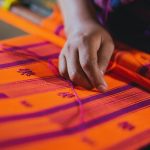Are you tired of dealing with frayed denim edges? Look no further! In this article, we will explore the question, ‘Can I use fabric glue to stop denim fraying?’
Discover the benefits of using fabric glue, learn how to select the right one for your denim, and follow our step-by-step guide to successfully prevent fraying.
With a little bit of glue and some simple techniques, you can keep your denim looking neat and polished. Say goodbye to frayed edges once and for all!
Table of Contents
Understanding Denim Fraying
Denim fraying can be prevented by using fabric glue. To understand denim durability and the causes of denim fraying, it’s important to know how denim is made and how it wears over time.
Denim is a strong, durable fabric made from cotton twill weave. The tight weave and the use of indigo dye give denim its characteristic strength and color. However, over time and with regular use, denim can start to fray.
There are several factors that can contribute to denim fraying. One common cause is the constant rubbing and friction that occurs when we wear denim. This friction weakens the fibers and causes them to break, resulting in frayed edges. Another factor is the quality of the denim itself. Low-quality denim may have weaker fibers or looser weaves, making it more prone to fraying. Additionally, improper care and maintenance, such as harsh washing or drying methods, can accelerate the fraying process.
Understanding these factors can help you take steps to prevent denim fraying. By using fabric glue, you can reinforce the frayed edges and prevent further unraveling. Fabric glue creates a strong bond between the fibers, effectively stopping the fraying process. It’s a quick and easy solution that can extend the lifespan of your denim garments.
Exploring the Benefits of Fabric Glue
To prevent fraying, you can try using fabric glue, which offers several advantages.
Here are some benefits and uses of fabric glue:
-
Easy application: Fabric glue comes in a convenient tube with an applicator tip, making it simple to apply directly to the fraying edges of your denim. You don’t need any special tools or skills to use it effectively.
-
Strong bond: Fabric glue forms a strong adhesive bond that holds the frayed edges together, preventing further unraveling. It creates a durable seal that withstands regular wear and washing.
-
Versatility: Fabric glue can be used on various types of fabrics, including denim. Whether you’re dealing with frayed jeans, a jacket, or any other denim garment, fabric glue can help you fix the fraying edges quickly and effectively.
-
Time-saving: By using fabric glue, you can save time and effort compared to sewing or hemming the frayed edges. It’s a quick and easy solution to prevent further damage and maintain the integrity of your denim.
-
Cost-effective: Fabric glue is an affordable alternative to other methods of preventing fraying, such as taking your garment to a tailor. It’s a budget-friendly option that offers great results.
Selecting the Right Fabric Glue for Denim
When selecting the right fabric glue for your denim, it’s important to consider factors such as durability, drying time, and washability. Denim is a sturdy fabric, so you’ll need a strong adhesive that can withstand the wear and tear of everyday use. Look for fabric glues that are specifically designed for denim or heavy fabrics. Some of the best fabric glue brands for denim include Aleene’s Original Tacky Glue, Beacon Fabri-Tac, and E6000 Craft Adhesive.
Denim fraying is a common problem that many people face. It can occur due to factors such as frequent washing, rough handling, or poor quality stitching. Using fabric glue is a great way to prevent fraying and extend the life of your denim garments. When applying fabric glue to your denim, make sure to apply it evenly along the frayed edges and press them together firmly. Allow the glue to dry completely before wearing or washing your denim.
Preparing Your Denim for Gluing
Before you start gluing, make sure to properly prepare your denim by cleaning it and removing any loose threads or debris. This will ensure that the fabric glue adheres well and that your project turns out neat and professional. Here’s how to prepare your denim for gluing:
-
Clean the denim: Before applying fabric glue, it’s important to clean the denim to remove any dirt, oils, or stains. You can either hand wash the denim with mild detergent or machine wash it on a gentle cycle. Make sure to let it air dry completely before proceeding.
-
Remove loose threads: Inspect your denim for any loose threads or frayed edges. Use a pair of sharp scissors to carefully trim away any loose threads. This will prevent them from getting caught in the fabric glue and creating a messy result.
-
Smooth out the fabric: Lay your denim flat on a clean surface and smooth out any wrinkles or creases. This will provide a smooth surface for the fabric glue to adhere to and ensure a tidy finish.
-
Remove debris: Check the denim for any debris or particles that could interfere with the fabric glue application. Use a lint roller or a clean, damp cloth to gently remove any dust, lint, or stray fibers.
Step-by-Step Guide to Using Fabric Glue on Denim
If you’re wondering how to use fabric glue on denim to prevent fraying and repair your favorite jeans, you’re in the right place.
In this discussion, we’ll guide you step-by-step through the process of applying fabric glue to your denim, ensuring that your repairs are secure and long-lasting.
From preventing fraying to achieving a professional-looking repair, you’ll find all the information you need to keep your denim looking great.
Fabric Glue Application
You can definitely use fabric glue to stop denim fraying. It is a simple and effective solution to prevent the edges of your denim fabric from unraveling.
However, if you prefer to explore other options, there are fabric glue alternatives available such as fray check or fabric adhesive tapes.
When applying fabric glue to your denim, it is important to follow the proper techniques. Start by cleaning the frayed area and trimming any loose threads. Apply a small amount of fabric glue to the frayed edges, making sure to spread it evenly. Press down firmly to secure the fabric.
Allow the glue to dry completely before handling or washing your denim garment. Remember to always read and follow the instructions on the fabric glue packaging for best results.
Denim Fraying Prevention
If you’re tired of your denim jeans fraying and unraveling, don’t worry, there are ways to prevent it. Understanding the causes of denim fraying can help you take the necessary steps to avoid it. Here are some common causes and DIY denim repair methods:
-
Poor quality fabric: Low-quality denim is more prone to fraying. Invest in jeans made from durable material to prevent fraying.
-
Over-washing: Frequent washing can weaken the fabric, leading to fraying. Wash your denim jeans less often and opt for spot cleaning when possible.
-
Lack of reinforcement: Reinforcing the areas prone to fraying, such as the hem and seams, can help prevent further damage. Use iron-on patches or try your hand at visible mending techniques.
Step-By-Step Denim Repair
To start repairing your worn out jeans, gather a needle, thread, and scissors. Understanding denim materials and different types of denim repair techniques can help you restore your jeans to their former glory. Denim is a sturdy fabric made from cotton twill, known for its durability and versatility. When it comes to repairing denim, there are various techniques you can use, depending on the type of damage. Here is a helpful table outlining some common denim repair techniques:
| Technique | Description |
|---|---|
| Patching | Adding a fabric patch to cover holes or weak spots in the denim. |
| Darning | Weaving new threads into worn areas to reinforce the fabric. |
| Hemming | Shortening or lengthening the hem of the jeans for a better fit. |
| Seam repair | Stitching up ripped seams to strengthen the overall structure. |
| Zipper replacement | Replacing a damaged or broken zipper to restore functionality. |
Tips and Tricks for Successful Denim Fray Prevention
Looking for alternative methods to prevent denim fraying?
In this discussion, we will explore various options for fray prevention, including alternative techniques and products such as fabric glue.
Find out the best fabric glue recommendations to effectively stop fraying and keep your denim garments in great shape.
Alternative Fray Prevention Methods
There’s an alternative method to prevent denim fraying using clear nail polish. While fabric glue is commonly used for fray prevention, clear nail polish can also be an effective solution. It creates a protective barrier that helps keep the edges of the denim intact. To apply the clear nail polish, simply brush it onto the frayed areas, allowing it to dry completely before wearing or washing the denim. This method is especially useful for small frayed spots or when you don’t have fabric glue on hand. However, if you prefer using fabric glue, here are some recommendations for the best ones:
| Fabric Glue | Features |
|---|---|
| Aleene’s Original Fabric Glue | Dries clear, flexible, machine washable |
| Beacon Fabri-Tac Permanent Adhesive | Quick drying, forms a permanent bond |
| Tear Mender Instant Fabric and Leather Adhesive | Waterproof, flexible, bonds quickly |
Remember to always follow the instructions provided by the manufacturer for best results.
Best Fabric Glue Recommendations
If you need a reliable adhesive for securing fabric edges, consider Aleene’s Original Fabric Glue, Beacon Fabri-Tac Permanent Adhesive, or Tear Mender Instant Fabric and Leather Adhesive. These fabric glues are great alternatives to sewing for denim repair and can help prevent fraying.
Here are some reasons why fabric glue can be a DIY solution for denim fraying:
- Ease of use: Fabric glue is easy to apply and dries quickly, making it convenient for quick denim repairs.
- Durability: Good fabric glues provide a strong bond that can withstand regular wear and washing, ensuring your denim stays intact.
- Versatility: Fabric glues are not only suitable for denim but can also be used on other fabrics, making them a versatile option for various projects.
Caring for Denim Repaired With Fabric Glue
After repairing your denim with fabric glue, it’s important to follow specific care instructions to ensure longevity. Caring for fabric glue repairs is essential for maintaining the long-term durability of your denim. Here are some tips to help you properly care for your denim after using fabric glue:
-
Washing: When washing your denim, turn it inside out to protect the fabric glue. Use a gentle cycle and cold water to prevent any damage. Avoid using harsh detergents or bleach, as they can weaken the glue bond.
-
Drying: Air drying is the best option for preserving the fabric glue repair. Hang your denim in a shaded area to avoid direct sunlight, which can cause fading. Avoid using a dryer, as the heat can weaken the glue bond.
-
Ironing: If necessary, iron your denim on a low heat setting. Be sure to place a cloth between the iron and the fabric to protect the glue repair. Avoid ironing directly on the repaired area to prevent any damage.
Following these care instructions will help maintain the integrity of your fabric glue repairs and ensure the long-term durability of your denim. Remember to always read and follow the care labels on your denim for specific instructions.
Conclusion
In conclusion, fabric glue can be a convenient and effective solution for preventing denim fraying. By understanding the process of denim fraying and selecting the right fabric glue for denim, you can successfully repair and prevent fraying.
Following the step-by-step guide and utilizing tips and tricks for application, you can achieve great results. Remember to properly care for your denim after using fabric glue to ensure its longevity.
With fabric glue, you can confidently stop denim fraying and extend the life of your favorite jeans.
- How Does Ring Spun Cotton Affect Garment Fit and Shape Retention? - August 13, 2024
- What Are the Challenges in Producing Ring Spun Cotton? - August 13, 2024
- Is Ring Spun Cotton Suitable for Plus-Size Clothing? - August 13, 2024




